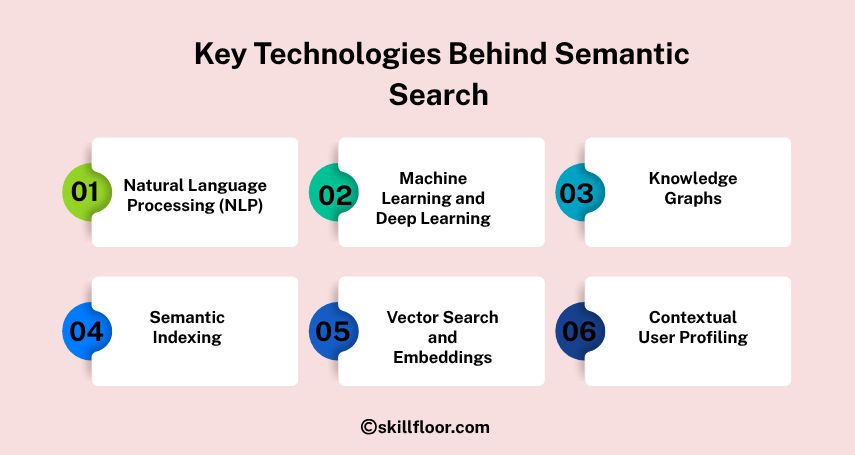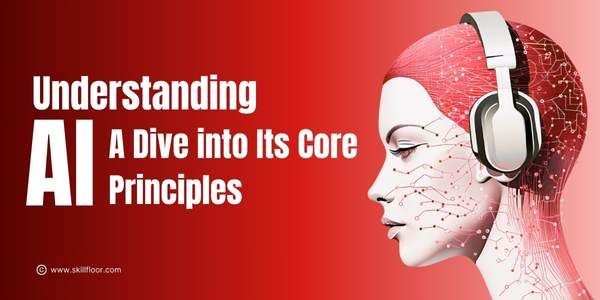What Is Semantic Search and How Does It Work?
Learn what semantic search is, how it works, and the advanced AI technologies behind it to deliver smarter, context-aware, and highly relevant search experiences.

The world of search has entered a new era. In the early days of the internet, users needed to think like machines. They had to type exact keywords, match formats, and structure queries in specific ways to retrieve the right information. Searching felt rigid and mechanical. Today, things feel entirely different. You can ask a search engine a full question, speak naturally, or even show an image and still receive relevant and contextual results. You can type “best laptop for travel with long battery life,” and the search engine instantly understands your intent and delivers results that make sense. This remarkable shift in search experience has been made possible by semantic search.
Semantic search represents a leap in the intelligence of search engines. Rather than relying solely on keyword matching, semantic search interprets the meaning behind the words, understands relationships between concepts, and predicts the true intention of the user. This deeper comprehension is fueled by artificial intelligence, natural language processing, data graphs, and machine learning technologies. It also breaks down how major platforms like Google leverage semantic search to deliver better results, real-world use cases, industry impact, and the future of search. For business owners, SEO professionals, students, developers, and everyday users, understanding semantic search is essential to navigating the digital environment more effectively.
What Is Semantic Search?
Semantic search refers to search systems capable of understanding the meaning, relationships, context, and user intent behind search queries. It is fundamentally designed to interpret human language naturally and intelligently.
Semantic search moves away from literal keyword matching into contextual and conceptual interpretation. It processes the semantics, or meaning, of a query.
With semantic search, engines can:
-
Understand user intent even when explicit keywords are missing
-
Detect relationships between entities such as people, places, or products
-
Interpret natural language, including questions and colloquial expressions
-
Personalize outputs based on user history, demographics, and behavior
-
Deliver results closer to what the user had in mind rather than what they typed
Here is a simple example:
A user types:
“Who is the CEO of the company that created Windows?”
A traditional search engine might struggle because:
-
The query does not explicitly mention Microsoft
-
“CEO” could relate to thousands of companies
-
The question requires contextual inference
A semantic search engine instantly understands the relationships:
-
Microsoft → Windows → Satya Nadella
It maps the concepts together and delivers the correct answer.
In summary
Semantic search does not look only at the words. It looks at the meaning. It operates more like the human brain, enabling more intuitive and intelligent access to information.
How Semantic Search Works
To deliver relevant answers, semantic search engines follow a layered approach that involves understanding:
-
Query meaning
-
User intent
-
Context of the search
-
Meaning of the information available
-
Relationships between concepts
Semantic search includes several key functions:
1. Understanding Natural Language Queries
Users type queries in human language, often ambiguous and incomplete. Semantic search parses sentence structure, grammar, and implied meaning.
Identifies and classifies meaningful elements in text, such as
-
Names of people
-
Brands and organizations
-
Geographic locations
-
Products
-
Events
3. Concept and Context Interpretation
Search engines do not just understand a single query but also:
-
Analyze previous searches
-
Consider user preferences and behavior
-
Factor in device location and time
For example, “best restaurants near me” changes results from morning to evening.
4. Ranking by Semantic Relevance
Results are prioritized not by keyword frequency but by:
-
Semantic similarity to the intent
-
Content credibility
-
Behavioral patterns (clicks, bounce rates, dwell time)
5. Continuous Learning
Machine learning enables the system to improve accuracy with every interaction.
This intelligence-driven workflow produces highly relevant search experiences.
Key Technologies Behind Semantic Search
Semantic search integrates multiple AI-driven technologies to function effectively.
1. Natural Language Processing (NLP)
Enables systems to interpret human language, understand grammar and context, and disambiguate meaning. NLP allows search engines to process questions such as:
-
“How tall is the tallest building in the world?”
and deliver direct answers.
2. Machine Learning and Deep Learning
Algorithms learn from user behavior and patterns. They refine search result quality over time.
3. Knowledge Graphs
Structured networks that map interconnected relationships between entities. These graphs contain billions of facts related to:
-
People
-
Places
-
Brands
-
Products
-
Concepts
Google’s Knowledge Graph is one of the largest examples in the world.

4. Semantic Indexing
Instead of indexing strings of text, semantic indexing represents meaning and relationships in vector form.
5. Vector Search and Embeddings
Words and phrases are converted into mathematical vectors so that semantically similar concepts are placed close together in a multidimensional space.
For example:
“Car,” “automobile,” and “vehicle” cluster together based on similar meaning.
6. Contextual User Profiling
Search engines personalize results using:
-
Search history
-
Browsing behavior
-
Geographic location
-
Device type
These technologies collectively power the intelligence of modern search experiences.
Semantic Search vs Traditional Search
Although both aim to deliver relevant results, traditional and semantic search engines operate differently.
|
Feature |
Traditional (Keyword) Search |
Semantic Search |
|
Based on literal keyword matching |
Yes |
No |
|
Understands user intent |
No |
Yes |
|
Handles natural language queries |
Limited |
Strong |
|
Recognizes synonyms and paraphrases |
Poor |
Excellent |
|
Uses the relationship between concepts |
No |
Yes |
|
Learns from behavior |
Very limited |
Advanced |
|
Personalization level |
Low |
High |
|
Provides direct answers |
Rare |
Frequently |
Semantic search delivers significantly more intuitive and user-friendly search results. Traditional search systems are practically becoming obsolete without semantic enhancements.
Impact on SEO and Content Creation
Writers now create content for people, not just search engines. Simple, useful information gets ranked higher in results. Helping users has become more important than just using exact keywords.
Writing for Topics, Not Just Keywords
These days, if you’re writing for the web, you have to really focus on answering what people are searching for. Instead of just adding keywords everywhere, explain the whole idea simply and clearly. Search engines look at how helpful your content *actually* is, not just how many times a search term pops up. This means your content needs to be useful, easy to get through, and cover everything about the topic. Like, if you’re writing a blog post about saving money, you should talk about specific tips, cool tools, and good habits. Don’t just write the word ‘save’ a million times. Good content will always beat trying to trick the search engines.
Optimizing for User Intent and Context
-
Use natural, easy-to-read language
-
Write full answers, not just short points
-
Add real-life examples to help readers
-
Keep content friendly for mobile and voice
-
Avoid repeating the same keyword many times
Real-World Applications of Semantic Search
Semantic search is used in voice assistants, apps, and shopping websites. It helps users find exactly what they want in less time. This is especially helpful when people use natural language or regional phrases.
Voice Search and Assistants
Voice assistants like Siri, Alexa, and Google Assistant use semantic search to understand what we say. When you say, "Play a happy song," the assistant gets that you’re after music that makes you feel good, not those exact words. And if you ask about the weather near me, it figures out where you are and gives you the forecast. These things get smarter as you use them. Nowadays, lots of people use voice search every day since it’s simple, fast, and just part of what they do.
Personalized and Local Search Results
-
Shows nearby shops, cafes, or services
-
Suggests content based on user interest
-
Uses local language or regional settings
-
Remembers past searches to improve future ones
-
Updates results instantly based on new information
Challenges and Limitations of Semantic Search
-
High Computational Requirements: Semantic search relies on deep learning models and large-scale data processing, which demand powerful infrastructure. This increases operational costs and limits adoption for smaller organizations.
-
Data Quality and Bias Issues: If training data contains inaccuracies or bias, search outputs can become misleading or discriminatory. Maintaining clean, diverse, and updated datasets is both resource-intensive and critical.
-
Language Ambiguity and Context Gaps: Human language often includes vague terms, metaphors, or multiple meanings. When contextual clues are weak, semantic systems may still struggle to interpret intent accurately.
-
Privacy and Personalization Concerns: To improve relevance, semantic search analyzes user behavior and personal data. This raises valid concerns about data tracking, transparency, and compliance with privacy regulations.
-
Complex Integration and Scalability: Deploying semantic search requires specialized AI expertise and continuous optimization. Supporting multiple languages and cultural nuances further complicates implementation at a global scale.
Semantic search has transformed digital information discovery by focusing on meaning, intent, and context rather than simple keyword matching. This shift enables faster, smarter, and more human-like search experiences across platforms and industries. Powered by AI, NLP, machine learning, and knowledge graphs, semantic search continues to advance personalization and relevance in every interaction. While challenges such as computational demands, data quality, and privacy concerns persist, innovation is rapidly addressing these limitations. As technology evolves, semantic search will remain essential in shaping the future of how people access, understand, and connect with information online.





























































